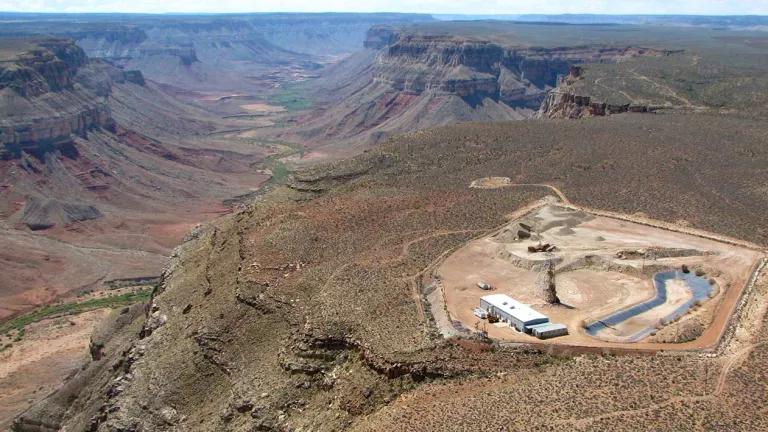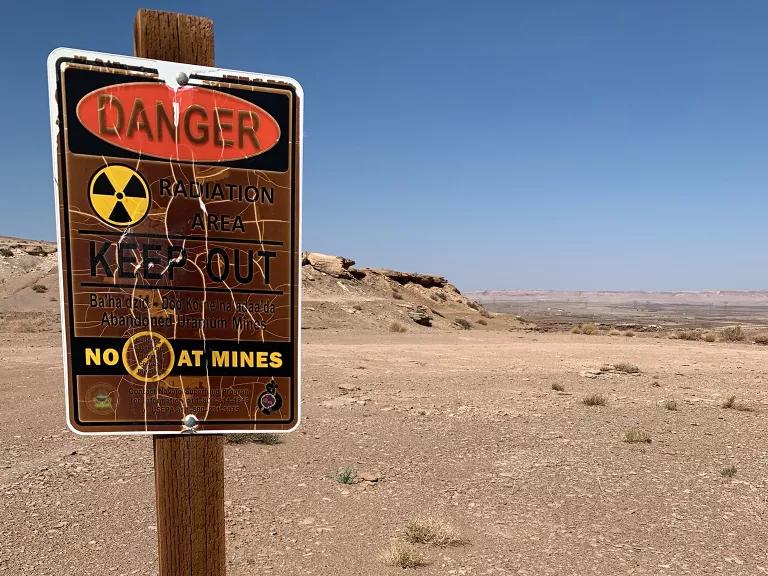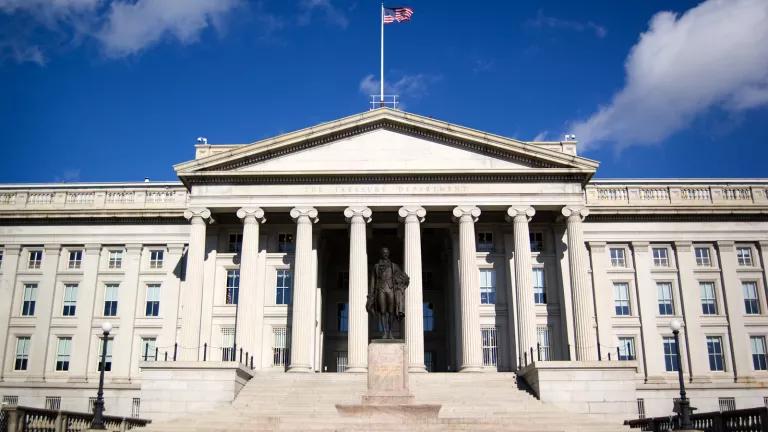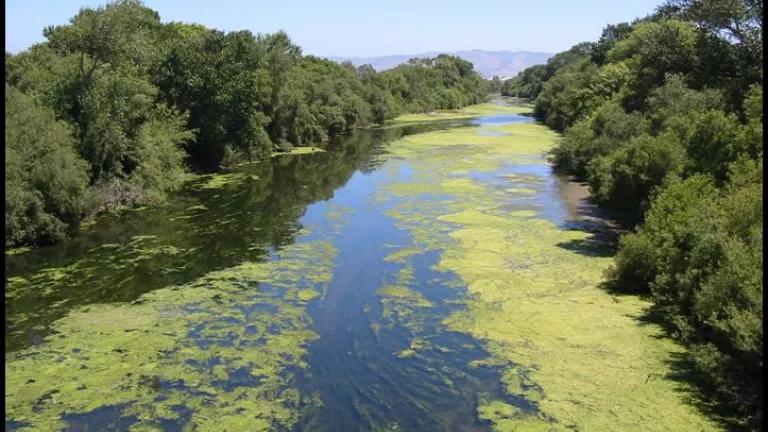Uranium Mining Protections Needed Across the West
The Biden administration needs to protect communities and water supplies across the West from the dangers of uranium mining.

The Kanab North uranium mine on the North Rim of the Grand Canyon
Bill Wills/USGS
President Biden’s designation of the Baaj Nwaavjo I’tah Kukveni—Ancestral Footprints of the Grand Canyon National Monument will go far in protecting the rich cultural and ecological value of this majestic landscape. It will safeguard some of the most iconic public lands in the American West from the ravages of destructive mining and destructive waste. This protection has been a top priority for tribes in the area, and the designation is long overdue.
“That’s our aboriginal homelands,” Dianna Sue Uqualla, a Havasupai tribal council member, told the Bureau of Land Management at a public meeting according to Bloomberg Law. The monument will “keep at bay these mining people that are coming in,” and will protect the Grand Canyon from companies that are “desecrating, raping the Mother Earth.”
This is wonderful news, but there is much more to be done about uranium mining across the American West. And there’s also a lot of misinformation out there that muddies what should be a clear path forward to protecting all the people and watersheds of the West from unchecked uranium mining.
Uranium mining contaminated tribal lands for decades
The uranium mining industry has left a dreadful history of contamination and harm across vast swathes of the American West, but especially with respect to the Indigenous People who call this area home. It’s a complicated history that intertwines with the Manhattan Project and the Cold War, and it’s a legacy that has yet to be addressed.
On Navajo land alone, nearly four million tons of uranium ore were extracted from 1944 to 1986. The industry and the U.S. government left behind hundreds of abandoned uranium mines, four inactive uranium milling sites, a former dump site, and the widespread contamination of land and water; this includes the 1979 collapse of a tailings dam in Church Rock, New Mexico, that deposited 93 million gallons of radioactive and chemically contaminated liquid and 1,100 tons of solid radioactive tailings into the Rio Puerco, contaminating the river for more than 60 miles downstream. After decades of pressure, the government has finally started to assess and mitigate this contamination.
Much is left to be done: More than 500 abandoned uranium mines remain on Navajo land.
We need new standards
Back in 2016, the Obama administration was poised to take action on uranium mining standards, but then Donald Trump was elected president. It will come as no surprise that the U.S. Environmental Protection Agency (EPA) under the Trump administration cast aside the Obama EPA’s long-overdue protective environmental standards. In an about-face, the Trump EPA and Nuclear Regulatory Commission (NRC) moved to weaken uranium mining rules.
Once Biden took office in 2021, NRDC had hoped for a new approach. So far, however, we haven’t heard anything from either the EPA or NRC, despite repeated requests by NRDC and other major environmental groups, tribal representatives, and regional groups across the West. It is time for the EPA to clear the obstacles and move forward on the uranium protections it drew up years ago.
The Biden administration can begin to protect the communities and water resources that have been negatively affected by uranium mining for decades by taking two steps: (1) dissolving a 2020 memorandum of understanding between the EPA and NRC that undercuts the EPA’s ability to enact standards; and (2) issuing protective uranium in situ mining standards that have been sitting on a shelf for years.

A sign warning of radiation at the site of an abandoned uranium mine on Navajo Nation land
Michael Regan, U.S. EPA via Twitter
Industries claim the usual objections
Just as a rooster crows at sunrise, the uranium and nuclear industries predictably took aim at President Biden’s designation, saying it would raise their costs, aid foreign adversaries, and harm efforts to address climate change.
Quite simply, this is ridiculous.
First, protecting one of the most iconic areas of the American landscape, and one that is important to literally a dozen tribes, is a profound good in and of itself.
Second, limiting uranium mining won’t affect cost or supply. Uranium makes up a small share of the costs of running a nuclear plant, and supplies are plentiful and available from many nations. Indeed, an unchallenged 2007 review of uranium supplies by Allison Macfarlane, the former chair of the NRC, found that the world had more than a century’s worth of relatively accessible stores of uranium.
Third, it’s wrong to claim this helps our adversaries abroad. After Russia invaded Ukraine, NRDC, along with many others, immediately joined calls to ban any purchase of Russian uranium. Nothing has changed on that front.
And Russia is not the top supplier of the uranium used in U.S. nuclear plants.
Russia has, over the years, provided a fluctuating portion of domestic reactor fuel, but it’s usually about 14 to 16 percent. While not an insignificant number, it’s certainly far from being a showstopper. And there is no shortage or supply chain concern for the existing fleet, even when removing Russian uranium from consideration. There is a long-established world market for uranium that, under current conditions, provides a product to its customers without major supply issues. The United States also has a store of excess uranium that can be accessed from the U.S. Department of Energy, if required. And two of the three most significant suppliers for the United States—Australia and Canada—are among our closest allies.
Last, it’s spurious to connect the domestic uranium market with somehow addressing the climate crisis. Over the past several years, the nuclear industry’s share of domestic low-carbon energy has been decreasing, and at a faster clip with each successive year. For example, in 2010, the nuclear industry provided 69 percent of domestic low-carbon electricity. By 2022, the nuclear industry’s contribution dropped to just half. This trajectory is likely to continue and, in fact, the U.S. Energy Information Administration said renewable energy will provide more power than nuclear by this year.
Uranium mining is inherently invasive and destructive—it needs protective standards
Uranium mining involves massive amounts of water in a region of our nation that’s facing severe water shortages. It can be done, however, provided it’s in compliance with vastly more protective standards, which include requiring the industry to clean up any contamination they cause in the process of mining. That’s the clear and simple standard that was laid out by the EPA in the uranium rule that the Trump administration nixed: Before mining a site, industry should be required to test the groundwater; then, once mining is done, it should clean up the water to the level it was before mining; and finally, it should transparently monitor the site to make sure the cleanup sticks, with either the EPA or the states overseeing this. It sounds straightforward, and it is.
All of the West deserves protection from groundwater contamination related to uranium, and it’s a shame that the Biden administration has not been willing—so far—to provide it.
While we will continue to fight for more comprehensive protections against such contamination, we celebrate the president's designation of the new Baaj Nwaavjo I’tah Kukveni—Ancestral Footprints of the Grand Canyon National Monument. This special landscape deserves enduring protection, and the creation of the monument honors the long-standing vision of the Grand Canyon Tribal Coalition.
This blog provides general information, not legal advice. If you need legal help, please consult a lawyer in your state.



